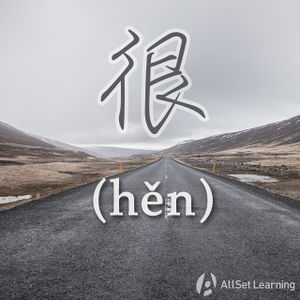Difference between revisions of "Simple "noun + adjective" sentences"
| Line 10: | Line 10: | ||
</div> | </div> | ||
| − | The noun in this structure is the subject of the sentence. Sometimes the 很 in this structure is translated as "very", but often it is just a way to link a noun to an adjective. | + | The noun in this structure is the subject of the sentence. Sometimes the 很 (hěn) in this structure is translated as "very", but often it is just a way to link a noun to an adjective. |
== Examples == | == Examples == | ||
| − | In the following examples, 很 is just a link, and the sentences could be translated as "(Noun) is (adjective)". | + | In the following examples, 很 (hěn) is just a link, and the sentences could be translated as "(Noun) is (adjective)". |
<div class="liju"> | <div class="liju"> | ||
| Line 31: | Line 31: | ||
</div> | </div> | ||
| − | Remember that '''是 is not used to link adjectives to nouns'''. This is a classic mistake that almost everyone makes when learning Chinese. Make sure you use 很 and not 是 to link adjectives to nouns, as shown below: | + | Remember that '''是 (shì) is not used to link adjectives to nouns'''. This is a classic mistake that almost everyone makes when learning Chinese. Make sure you use 很 (hěn) and not 是 (shì) to link adjectives to nouns, as shown below: |
<div class="liju"> | <div class="liju"> | ||
Revision as of 08:40, 13 June 2014
-
Level
-
Similar to
- Age with "sui" (A1)
- Connecting nouns with "shi" (A1)
- The "also" adverb "ye" (A1)
- Expressing "both A and B" with "you" (A2)
- Special verbs with "hen" (A2)
- Superlative "zui" (A2)
- Adjectives with "name" and "zheme" (B1)
- Reduplication of adjectives (B1)
- Adjectival complement "de hen" (B2)
- Emphasizing with "henshi" (C1)
-
Used for
-
Keywords
In English, nouns can be linked to adjectives and other nouns with the verb to be. In Chinese, nouns are linked in different ways to adjectives and other nouns. Nouns are linked to nouns with 是 (shì). Nouns are linked to adjectives with 很 (hěn).
Structure
Noun + 很 + Adjective
The noun in this structure is the subject of the sentence. Sometimes the 很 (hěn) in this structure is translated as "very", but often it is just a way to link a noun to an adjective.
Examples
In the following examples, 很 (hěn) is just a link, and the sentences could be translated as "(Noun) is (adjective)".
- 我 很 好。I'm good.
- 她 很 高。She's tall.
- 他 很 高兴。He is happy.
- 你 很 好看。You are good-looking.
- 大象 很 大。The elephant is big.
- 猫 很 小。The cat is small.
- 他 很 坏。He's bad.
- 我 家 的 狗 很 聪明。My family's dog is clever.
- 你 很 漂亮。You are beautiful.
- 中文 很 难。Chinese is difficult.
Remember that 是 (shì) is not used to link adjectives to nouns. This is a classic mistake that almost everyone makes when learning Chinese. Make sure you use 很 (hěn) and not 是 (shì) to link adjectives to nouns, as shown below:
- 他是高。
- 他很高。He is tall.
See also
Sources and further reading
Videos
- Yoyo Chinese: "To be" + Adjectives
Books
- Basic Patterns of Chinese Grammar (pp. 56-8) →buy
- Chinese: An Essential Grammar, Second Edition (pp. 44-5) →buy
- Integrated Chinese: Level 1, Part 1 (3rd ed) (pp. 126-8) →buy
- New Practical Chinese Reader 1 (新实用汉语课本1) (pp. 20-1, 143) →buy
- New Practical Chinese Reader 1 (新实用汉语课本1)(2nd ed) (pp. 23, 166, 249) →buy
- 40 Lessons for Basic Chinese Course (基础汉语40课上册) (p. 86)→buy



